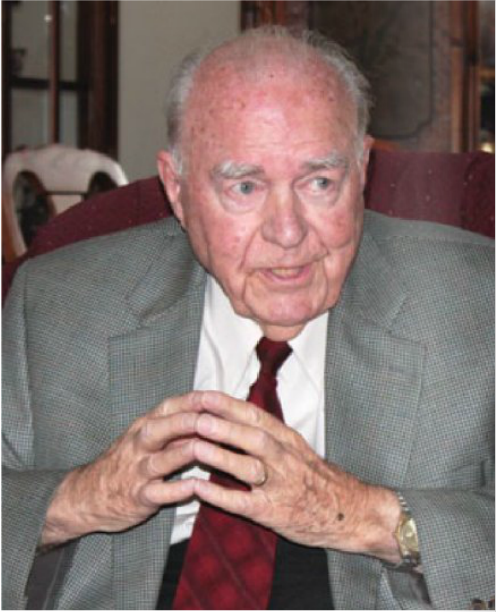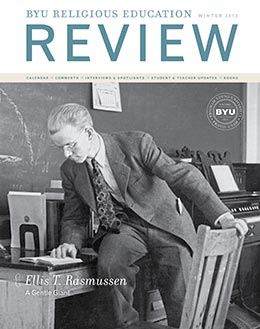Scott C. Esplin (scott_esplin@byu.edu) was an assistant professor of Church history and doctrine at BYU when this was written.

The Lord and his prophets have repeatedly emphasized the centrality of the Book of Mormon in Latter-day Saint religious education. “The elders, priests and teachers of this church shall teach the principles of my gospel, which are in the Bible and the Book of Mormon,” the Lord stressed in 1831 (D&C 42:12). Nearly 150 years later, President Ezra Taft Benson famously warned, “We have not been using the Book of Mormon as we should.” He added that “our homes are not as strong,” “our families may be corrupted by worldly trends and teachings,” “our missionaries are not as effective,” and “our Church classes are not as spirit-filled unless we hold it up as a standard.”[1] Because of these cautions, Religious Education at Brigham Young University includes the Book of Mormon as a core component of a university education, with all students expected to take two courses studying the text. However, such has not always been the case.
Failing to focus on the message of the Book of Mormon plagued the university like it plagued the early Church (see D&C 84:54–57). In his classic address to religion faculty in 1938, President J. Reuben Clark Jr. emphasized, “You are not to teach the philosophies of the world, ancient or modern, pagan or Christian, for this is the field of the public schools. Your sole field is the Gospel, and that is boundless in its own sphere.”[2] A year later, President Clark recorded in his office journal, “In connection with the general discussion of Church Education, I repeated my statement that the present courses in the Church Educational program contemplated the study of religion and ethics, with our own religion really as a part of this general study, rather than a study of the Gospel. It was agreed that this should be changed, and the Gospel should be made the essential thing.”[3] Shortly thereafter, the curriculum was revised. Religion professor Russel B. Swenson reported the impact of the changes: “About 1941 they had a new curriculum. . . . They had social dancing, they had psychology of religion, the sociology of religion, which were taught to get religious credit. They found that a man could go the full four years at BYU and not take a genuine religious course, so probably we had gone too far in deviating from religious courses.”[4]
While the curriculum was refocused on the gospel, the Book of Mormon was not the immediate emphasis. Keeping pace with the postwar growth of the university in the 1950s, the curriculum in Religious Education likewise expanded. Undergraduate courses in modern scriptures increased from three to ten, while those focused on the Bible jumped from one to twenty-one. Graduate offerings increased even more dramatically, expanding “from six to ninety-two, including forty-two in languages.” Of these, six graduate classes studied Latter-day Saint scripture, and ten examined Church history.[5]
However, though offerings were increased, the core of the curriculum had not been established. In 1960, university officials sought to focus religious study on campus, giving each “student a fundamental education of the Gospel of Jesus Christ.”[6] A new course in “Doctrines and Principles of the Gospel and Practical LDS Living” was proposed. Some individuals on the faculty vigorously opposed the idea, lobbying instead that a study of the Book of Mormon should form the core of the curriculum. David Yarn, dean of Religious Instruction at the time, noted that the debate “became sometimes very heated. . . . We discussed it and discussed it and discussed it.” Admitting afterward that he “was one who favored the theology class . . . because of its breadth,” Yarn recalled, “I prayed about that, and I prayed about that, and I prayed, thinking that inasmuch as I was the dean, that the Lord would let me know what really should be done, what he wanted, because I got all these ideas of what the men wanted, but I wanted to know what the Lord wanted. . . . Finally, one night . . . I knelt behind the bed . . . and prayed. And just as clearly as anything I ever experienced, I heard the words, ‘The Book of Mormon is the course that should be taught.’”[7] Yarn’s witness coincided with support from Elders Harold B. Lee and Marion G. Romney, who recommended “that the basic course required for all freshman at the Brigham Young University and in every other Church School be the ‘Book of Mormon.’ Since, as the Prophet Joseph Smith said, The Book of Mormon, ‘is the keystone of our religion,’ we think it should be taught to every student.”[8]
Today, the study of the Book of Mormon serves as the foundation for a student’s religious instruction at Brigham Young University. In fall 2011, 107 Book of Mormon class sections fortified the faith of more than 6,800 students on campus. Religious Education seeks to fulfill President Benson’s prophecy: “I have a vision of homes alerted, of classes alive, and of pulpits aflame with the spirit of Book of Mormon messages. . . . I have a vision of the whole Church getting nearer to God by abiding by the precepts of the Book of Mormon.”[9]
Notes
[1] Ezra Taft Benson, “The Book of Mormon is the Word of God,” Ensign, May 1975, 65.
[2] J. Reuben Clark Jr., “The Charted Course of the Church in Education,” in Charge to Religious Educators, 3rd ed. (Salt Lake City: The Church of Jesus Christ of Latter-day Saints, 1994), 7.
[3] J. Reuben Clark Jr. Diary: 1936–1939, 21 July 1939, 166, in J. Reuben Clark Jr. Papers, 1871–1961, MSS 303 addendum, box 9, folder 3; L. Tom Perry Special Collections, Harold B. Lee Library, Brigham Young University, Provo, Utah.
[4] Russel B. Swenson Oral History Interview, September 13, 1978, 16 UA OH 32, Special Collections, Harold B. Lee Library, BYU.
[5] Richard O. Cowan, Teaching the Word: Religious Education at Brigham Young University (Provo, UT: Religious Studies Center, Brigham Young University, 2008), 19.
[6] “Report of Committee on Requirements of Religion and their Relationship to the General Education Requirements,” May 1960, 2, cited in Cowan, Teaching the Word, 25.
[7] David H. Yarn Jr., interview by Scott C. Esplin and Brent Nordgren, October 8, 2009.
[8] Harold B. Lee and Marion G. Romney to the Church Board of Education and BYU Board of Trustees, March 15, 1961, cited in Cowan, Teaching the Word, 26–27.
[9] Ezra Taft Benson, “Flooding the Earth with the Book of Mormon,” Ensign, November 1988, 6.
